Aircraft Noise and the Typical Aircraft that Utilize Cape Fear Regional Jetport
Does that aircraft seem loud or low? The following information explains who uses our airport and why. There is also a section on the altitudes aircraft fly, which determines how loud and low they appear.
If, after reviewing this section, you believe an aircraft was unsafe by flying abnormally from what is described, contact us via the email or via phone at: (910) 457-6483.
Background: As a public airport, Cape Fear Regional Jetport (KSUT) is available to any and all pilots who desire to use it. KSUT is our International Civil Aviation Authority (ICAO)/ Federal Aviation Authority (FAA) designation.
Pilots and aircraft owners are responsible to ensure their aircraft meet the published runway size and weight restrictions at the airport. KSUT is one of two public airports in Brunswick County; the other is the Odell Williamson Airport in Ocean Isle (60J).
According to the North Carolina Airports Association (NCAA), "there are 72 public airports in North Carolina which contribute nearly $26 Billion to the state's economy, which is 6 percent of the state's gross domestic product (GDP)."
Airline operations are not conducted at KSUT due to higher Federal Aviation Administration (FAA) fire response, passenger screening and airport security requirements.
Some of the more common users of Cape Fear Regional Jetport include aircraft stationed here (based) and visiting (transient) aircraft. Before describing our common our users, let's discuss a common concern: approach altitudes.
Flying Too Low?
Often aircraft noise complaints stem from the perception of aircraft flying too low. Individuals hear
noise, look up and see the aircraft overhead. Larger aircraft will seem even lower due to their size
and the lack of frame of reference above them. But these aircraft are probably not too low and here is why.
Understandably, pilots have a vested interest in not flying too low. And the Federal Aviation Administration (FAA) establishes, certifies and inspects these approach paths on a periodic basis. The FAA established a minimum separation distance from the natural (i.e. trees) and man-made (buildings, powerlines, even roads) below them. That glide path is defined by both electronic and visual equipment. Cape Fear Regional Jetport is equipped with these navigational aids at each runway end. This equipment continuously advises the pilot if the aircraft is above, on, or below the FAA 3-degree, certified precision approach path. You might see these visual Precision Approach Path Indicators (known as PAPI's) as two sets of red lights. If you were higher, the colors would be red and white (see figure below). Normally, piston driven propeller airplanes will stay at 1,000 feet until turning in to land, and usually intercepts these light signal path on final at or above 500 feet. Jet aircraft are required to remain at 1,500 feet until established on final and intercepting these visual light signals.
Coincidental is the electronic glide path information provided by the WAAS GPS satellite system for both ends of the runway. This system guides the appropriately equipped aircraft on an instrument approach, through the clouds until the pilot can see PAPI lights. If the pilot does not see the PAPI lights when arriving at 250 feet above the runway, he/she will execute a 'missed approach' which has the airplane start climbing back up and either try it again, or go somewhere else. For non-equipped aircraft, the aircraft cannot descend below 400 feet above the runway until the runway environment / these light signals are visible. These visual / electronic glide paths guide the airplane to touch down a little more than 1,000 feet past the beginning of the runway.


Here are some of Cape Fear Regional Jetport's common users.
Military: Most military branches use KSUT. Sometimes military aircraft fly practice instrument approaches, and/or practice landings. Occasionally, military aircrews, or senior leaders use KSUT as a transient facility for access to Sunny Point Military facility.
 |
MV-22 Osprey is the newest aircraft in the USMC and Air Force Inventory. Cherry Point Marine Air Station (83 flying miles northeast) has nearly two dozen Osprey aircraft assigned. Normally these aircraft dispense to the various local airports, including KSUT, to conduct approach & landing training. |
| UH-60 Blackhawk: The US Army uses this helicopter in a variety of roles. Fort Bragg and Several Army Guard units visit Cape Fear Jetport when practicing long range flights. |  |
Local Law Enforcement: KSUT offers 24-hour self-serve fueling capability for both piston engine and Jet aircraft.This allows police and rescue operations the capability to fly all hours and refuel when necessary
 |
Left: Southeastern North Carolina AirBorne Law Enforcement (SABLE) OH-58C helicopter. Right: Brunswick County Bell OH-58 helicopter. |
 |
Medical and Rescue Helicopters: These specially equipped helicopters offset their equipment by having less fuel capacity. KSUT's 24-hour self-serve fueling eliminates a 25-mile flight to the next closest aviation fuel source (Wilmington Int'l Airport).


Local Flight Operations: KSUT has several flight operations that provide aircraft training, and/or local area tours. They support the local tourism, pilot education and proficiency, and are known leaders in the community. Most of their aircraft use smaller, 4- cylinder engines including a Cessna 172, Cessna 152, and helicopters including a Robinson R22 and R44.



Unique Flight Operations: There are three operations at KSUT that require special profiles:
- Coastal Carolina Skydiving: For those that enjoy this thrilling endeavor, an aircraft needs to bring them to their jumping altitude; usually 5,000 or 11,000 feet depending on their type of jump. The airplane that brings them to altitude does so at a full power, best rate of climb airspeed for two reasons; safety and minimizing noise. The airplane needs to climb into the wind to allow jumpers to return to the airport after departing the airplane. The stronger the winds, the more important the climb direction. Calm winds allow the pilot more leeway in determining the climb path.
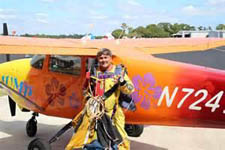



The movie, 'Iron Man 3' rented hundreds of jump flights out of KSUT for two weeks to file the Air Force One scene.
- Aerobatic Flights: One KSUT airport business owner is a 20+ year,Ultimate Air Race Championship pilot who flys, builds and teaches aerobatic flying as well as provides aerobatic introduction flights. The aerobatic practice area is over water, off the coast of Bald Head Island.


- Flight Tours and Instruction: Brunswick Air is a local flight school which provides primary and instrument flight instruction using two and four seat Cessna aircraft. They also provide air tours and introductory flights. While take-off and landing training is conducted at the airport. Most other local training is flown at or above 3,000 feet, either over water or the unpopulated areas at less populated areas of Bald Head Island.
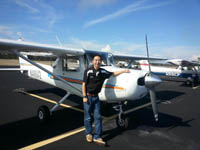
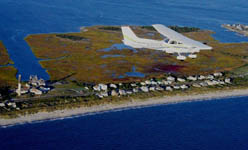
- Antique Aircraft Flight Tours: Another tour operator provides two-person aerial tours in the local area. The unique sound of the radial engine is hard to miss, but the engine is only operated at full throttle during take-off operations.


- Helicopter Training, Flight Tours, and Aerial Photography: High Tide Helicopters, Inc. provides single engine helicopter training in Robinson R-22 (two seat) and R-44 (four seat) helicopters. Their operation, similar to all flight school and tour operations are evaluated by the FAA on a recurring basis. While fixed wing aircraft can be used for aerial photography, helicopters provide the advantage of a stable platform to frame the photo as necessary. Residents might be concerned about a helicopter hovering near their location, but it is usually because of a photography need of the client on board.


- Civil Air Patrol: KSUT hosts the Brunswick Country Civil Air Patrol Composite Squadron. The North Carolina Civil Air Patrol Wing assigns this unit a specially equipped, Cessna 172 or 182 aircraft for training and real world operations. Some of the electronic search methods involve higher altitude flying at 4,000 - 10,000 feet. However, a majority of the search patterns are flown at 1,000 feet in order to conduct ground searches and/or aerial photography. During these maneuvers, the aircraft is flown at specific speeds which reduce fuel consumption and noise.

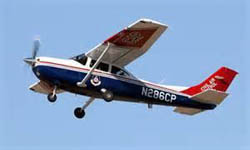
Airport Based Services: Aircraft maintenance support needs to be located at the airport to provide airplane access. Several individuals are FAA certified mechanics who work on local and also transient aircraft. An avionics specialty shop recently relocated to KSUT which brings various types of aircraft to the airport.
Local Based Aircraft: Mostly, Cape Fear Jetport is home to single engine, piston airplanes. Two turbine engine aircraft are hangared at KSUT;a Pilatus PC-12, & a Cessna Mustang Light Jet.
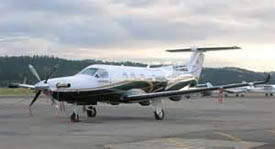
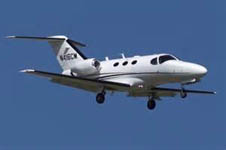
Transient Aircraft: Cape Fear is a destination for business jet and piston engine aircraft. Whether business or pleasure, these aircraft drop off / pick up passengers or spend a few days in the Southport / Oak Island / Bald Head Island area.
KSUT is also a popular place for pilots to visit just to conduct training or proficiency flights. Often piston engine aircraft will fly-in, grab lunch, and head back to their home base, a common practice in aviation.
 |
(Left) Global 650 (Right) Cessna Citation |
 |
Aircraft visiting the airport often require fuel. Smaller aircraft may purchase just a few gallons, or top-off. Jets often purchase hundreds on gallons, and on occasion, the larger jets will buy more than a thousand gallons. The amount all depends on the aircraft's maximum available weight, the distance the pilot plans on flying, the weather, and the fuel price. While there are additional concerns, if the destination fuel price is significantly higher that KSUT's, aircraft will usually buy the more fuel here.
NCAA estimates NC airports support more than 108,000 jobs. State and local governments received more than $770 million in sales, property, corporate and presonal taxes due to airport activity.
Aviation and aerospace continue to be an intergral part of North Carolina's economic engine.
"Money doesn't drive in - money flies in"